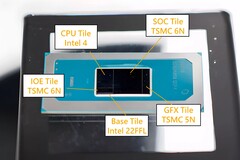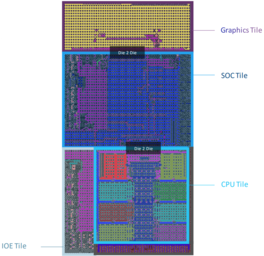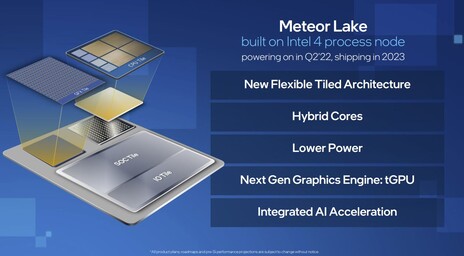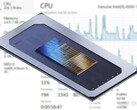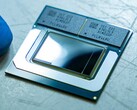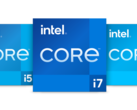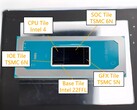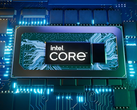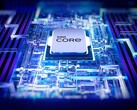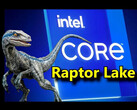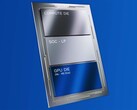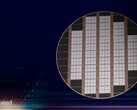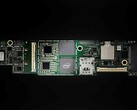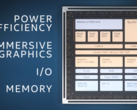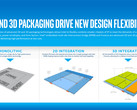Intel has revealed some new information pertaining to its upcoming processor generations viz. Meteor Lake, Arrow Lake, and Lunar Lake. Intel previewed its processor advancements during its Hot Chips 34 event yesterday.
Meteor Lake, Arrow Lake, and Lunar Lake will make use of Intel Foveros 3D packaging technology. Intel first introduced Foveros with Lakefield hybrid CPUs, but they had only a limited run. Meteor Lake will be the first to have a more mainstream application of Foveros tech. Intel will be bringing together discrete CPU, GPU, SoC, and I/O tiles onto a single package.
Among these tiles, Intel will be making one while the rest are produced by TSMC. Intel is tight-lipped about the process node for the tile GPU (tGPU), but industry sources seem to indicate that it could be TSMC's N5 5 nm node. The CPU will be based on Intel 4 (7 nm) while the SoC and I/O tiles will be fabbed on TSMC N6 6 nm. The Foveros interposer itself is fabbed on a 22 nm node and will be made by Intel.
Intel also showed off a design of Meteor Lake core with six Performance (P) cores and eight Efficiency (E) cores. The P cores are likely based on Redwood Cove while the E cores are based on Crestmont. We learn that Intel is targeting Meteor Lake and Arrow Lake for the performance desktop and laptop segment while Lunar Lake will address the needs of the 15 W and below market.
Intel hopes that the Foveros 3D packaging tech will make the processors more cost-effective and compete with conventional monolithic designs. The company is also confident that the Foveros tile does not bring with it any bandwidth or latency limitations and that it will indeed match the intended performance and power efficiency targets.
Apart from the new Core architecture, Intel also briefly touched upon Ponte Vecchio, which is again a tile-based GPU that makes use of embedded multi-die interconnect bridge (EMIB) and Foveros packaging tech. Ponte Vecchio is targeted at data centers and other high-performance computing (HPC) workloads.
Then we have the Xeon D-2700 and 1700 processors targeted at IoT, 5G, and cloud applications. Intel also wants to use the chiplet-based approach for its FPGAs with a particular focus on radio frequency applications. More information on these will be shared soon.
Intel is expected to ship Meteor Lake processors in Q4 2023.
Meteor Lake tGPU to support ray tracing
We also get to know some information about Meteor Lake's tGPU. The Meteor Lake tGPU will be based on the Xe-LPG architecture, which is a derivative of Xe-HPG that is currently used by Intel DG2 Arc Alchemist. Xe-LPG apparently misses out on support for Dot Product Accumulate Systolic (DPAS) due to lack of Xe Matrix eXtension (XMX) units.
This information comes via the latest patches added to the Intel Graphics Compiler and were first spotted by Coelacanth's Dream. The author notes,
Regarding support for HW ray tracing on Meteor Lake GPUs... there is no change in the code part that determines his HW ray tracing support, so it seems that Meteor Lake GPU supports it as well as Alchemist/DG2 and Ponte Vecchio."
It is good to see integrated graphics evolve to support compute-intensive features such as hardware-accelerated ray tracing. AMD Ryzen 6000 APUs already have RDNA 2-based iGPUs like the Radeon 680M that support HW ray tracing.
It remains to be seen how many execution units will Intel equip its Meteor Lake tGPUs with. It is verily possible that Intel's tile-based approach will see succeeding CPU generations feature even more capable tGPUs that can rival entry-level desktop cards, thermal constraints and package power limitations notwithstanding.
Buy the Asus VivoBook 16X with Core i7-12700H and Intel Xe Graphics on Amazon


 Deutsch
Deutsch English
English Español
Español Français
Français Italiano
Italiano Nederlands
Nederlands Polski
Polski Português
Português Русский
Русский Türkçe
Türkçe Svenska
Svenska Chinese
Chinese Magyar
Magyar